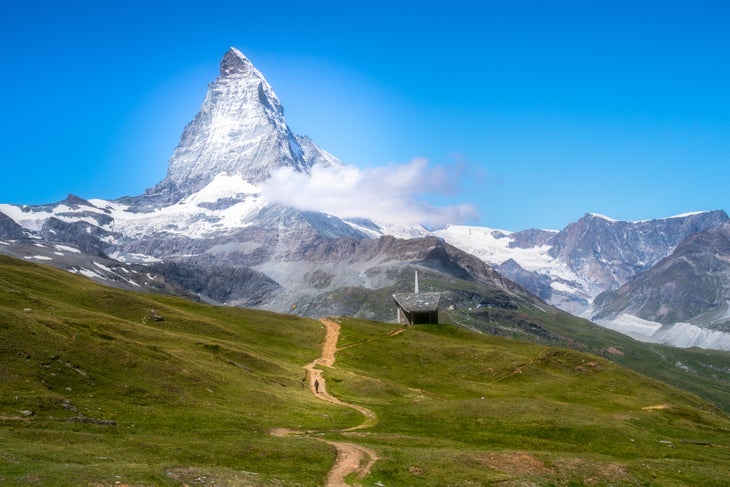Heading out the door? Read this article on the new Outside+ app available now on iOS devices for members! Download the app.
1. At 4,478 meters (14,692 feet), the Matterhorn is only Western Europe’s 12th-highest peak, but it is taller than Mt. Whitney, the highest summit in the Lower 48 of the U.S., by about 187 feet.
2. The Matterhorn straddles two countries, Switzerland and Italy, and has three common names. The German name Matterhorn derives from the words for “meadow” and “peak.” The Italian name (Cervino) and French (Cervin) likely originated with the Latin word for forest, silva, though some believe it comes from the Italian and French words for “deer.”
3. The first ascent on July 14, 1865, from the Swiss side of the mountain, ended a race that lasted nearly a decade and came down to the wire, with rivals on the Italian side poised only 1,250 feet below the top when Edward Whymper and Michel Croz first reached the summit. In order to ensure his rivals knew they were beaten, Whymper rather unsportingly shouted at the Italian team from the top and hurled rocks to make a clatter. “The Italians turned and fled,” Whymper wrote in his famed book Scrambles Amongst the Alps.

4. The glorious victory was marred when, during the descent, four of the seven climbers in the summit party fell to their deaths. The remaining three, including Whymper, likely would have fallen as well if the rope linking the men had not broken.
5. The second route up the Matterhorn, the Lion Ridge from Italy, was completed just three days after the first, on July 17, 1865.
6. Since the first ascent, more than 500 people have died while climbing or descending the Matterhorn—an average of three to four per year.
7. About 3,000 people summit the Matterhorn annually. However, starting this year, by reducing the size of the hut at the base of the most popular route, the Hörnli Ridge, and eliminating camping outside the hut, Swiss officials hope to slash the number of climbers by as much as one-third and reduce crowding on the mountain. About 80 percent of Matterhorn climbers are either guides or clients.
8. Both a railway and a cable car to the summit of the Matterhorn have been proposed. The latter, a tramway from the Italian town of Breuil-Cervinia, was proposed in 1950 but scuttled after tens of thousands of people protested to the Italian government.
9. Emil Cardinaux’s striking poster of the Matterhorn (shown above), designed as a card in 1903 and printed as a tourism poster for Zermatt in 1908, is considered the first modern travel poster and a landmark of 20th-century design.
10. In 2019, after an uptick in rockfall related deaths, there was a (brief) discussion about closing the mountain to climbers after an anonymous guide told a Swiss newspaper that climate change had made it increasingly unstable and dangerous.